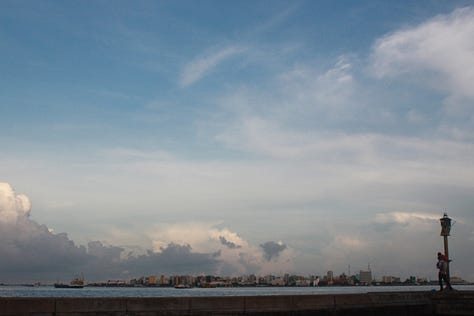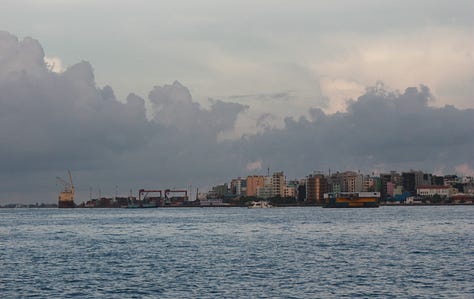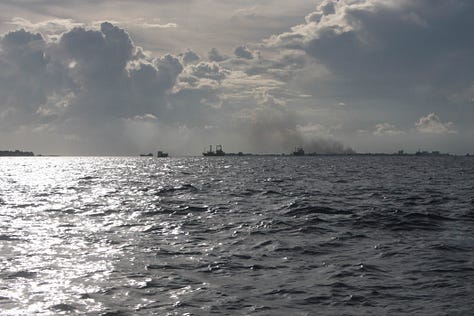Crowded capital
200 hectares, 150,000 people, 68,000 motorbikes (3 minute preview, 8 minute read)
Before I finish writing about the Maldives, I want to talk about Malé, even though the Maldivian capital is not as obscure as the other islands I’ve written about. When I was there, it was only about 20 minutes on a ferry from the international airport, and it’s now linked to the airport via the Sinomalé Bridge. I definitely saw tourists there, but I still think it’s obscure and interesting enough to justify an article.
Technically, the capital of the Maldives is not only the island of Malé. There are a number of islands which together make up the capital. As well as Malé itself, there’s the island where the airport is, the island where the rubbish tip is, the island where the prison is, an island used for fuel storage, the sleepy island of Villingili and the artificial island of Huhlumalé, which was built to take pressure off the main island. When I visited, I stayed on Malé for a few days and Huhlumalé for one night just before I left. I also visited Villingili and the airport, but not the rubbish tip, prison or tank farm.
Even before I landed on Malé, I could see that it was crowded. The entire island appeared to consist of multi-storey buildings. Once I arrived, I saw that my first impression was correct. Every inch of land was used. Not a blade of grass grew that wasn’t intentional. It was a strange place for someone teaching invasive plant management.
My second impression was that Malé was an island of motorbikes, and they made it difficult to get around. If it was just people riding from one place to another, it would have been fine. I can cross busy roads – I’ve walked around Rome and parts of Kerala in India without being run over. The problem was the space between the footpath and the moving traffic. Male’s roads were lined with parked motorbikes. They were parked so close, it was often impossible to get through. I had to walk up and down the footpath until I found a gap.



The main island of Malé is so tiny that the need for 68,000 motorbikes is debatable. The only reason I was ever in a vehicle was because I was carrying luggage or resources for my training course. Malé is around a kilometre long and around 500 metres wide at its widest. It covers about 200 hectares and I walked all around it in the limited time I had. It’s almost unimaginable how densely populated this island is – when I was there the population was 153,000. That’s around three quarters of the population of Wellington City, crammed into an area less than the Zealandia Sanctuary.
Another immediate impression I had of Malé was that everyone stared at me. There was a reason, though. I was coming from Kerala in South India, and I had been wearing clothing that was suitable for the culture and climate there. My New Zealand summer clothes wouldn’t be appropriate in Kerala, which is conservative in terms of how much skin is exposed. I had contacted the people I was going to be working with and asked about getting clothing there – would that be a good idea, I asked. And if it was, could they recommend where I might find something suitable?
They did better than that. Within a couple of hours of my arrival, I was met by two female PhD students from the institute where I was teaching, along with a vehicle and a driver. They took me shopping and advised on what I should wear. A couple of hours later, I had half a dozen outfits suitable for every occasion I would encounter on my travels. They made sure I understood how to match the colours and styles in a way that a local would. Crucially, my trousers and scarf must match, but they could be complementary to my tunic.




